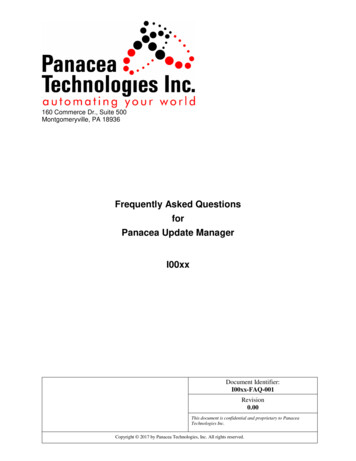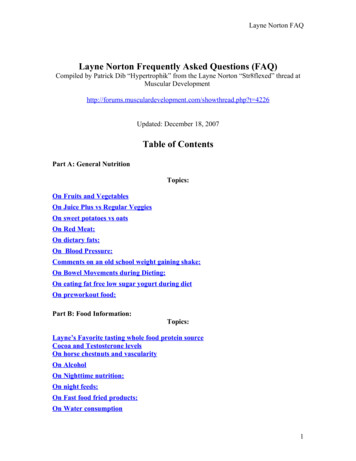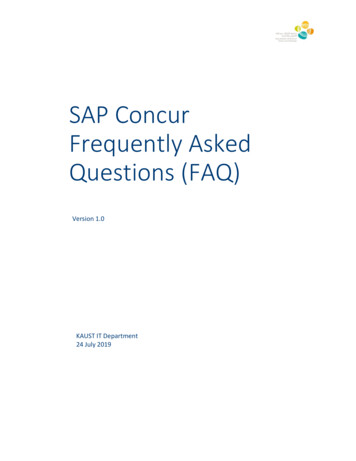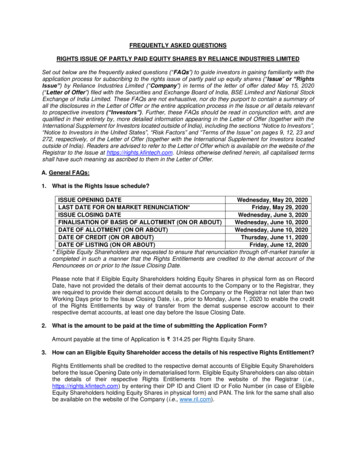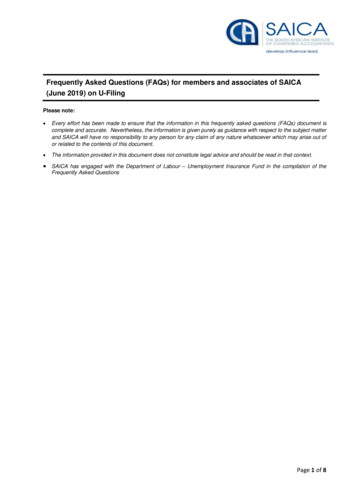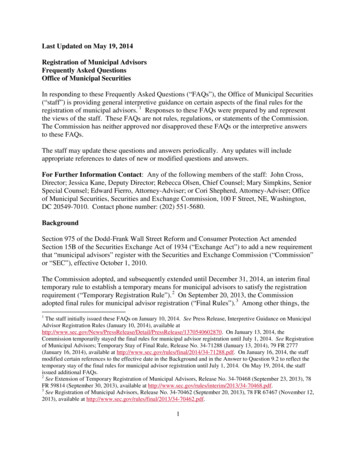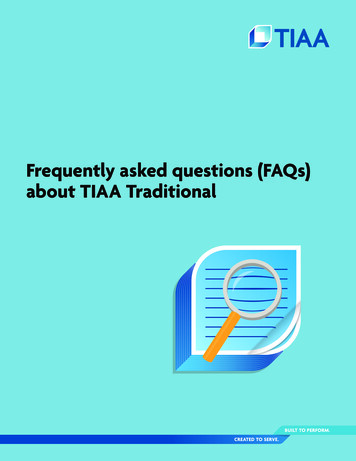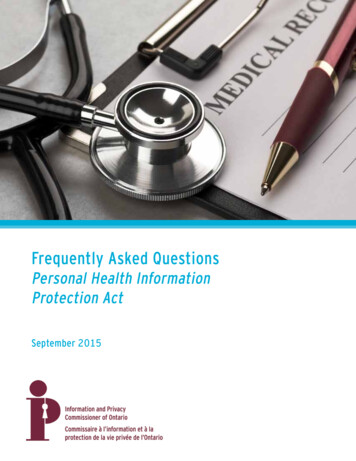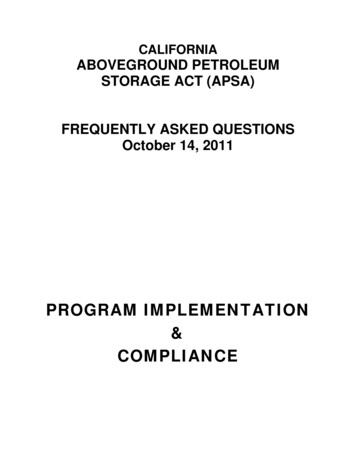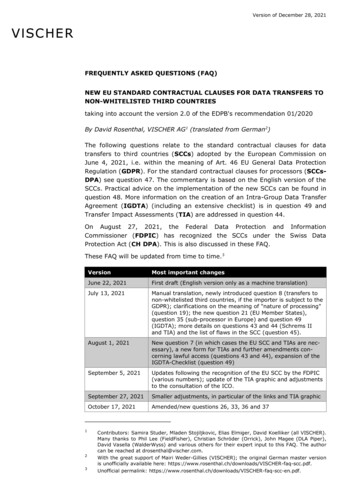
Transcription
Version of December 28, 2021FREQUENTLY ASKED QUESTIONS (FAQ)NEW EU STANDARD CONTRACTUAL CLAUSES FOR DATA TRANSFERS TONON-WHITELISTED THIRD COUNTRIEStaking into account the version 2.0 of the EDPB's recommendation 01/2020By David Rosenthal, VISCHER AG1 (translated from German2)The following questions relate to the standard contractual clauses for datatransfers to third countries (SCCs) adopted by the European Commission onJune 4, 2021, i.e. within the meaning of Art. 46 EU General Data ProtectionRegulation (GDPR). For the standard contractual clauses for processors (SCCsDPA) see question 47. The commentary is based on the English version of theSCCs. Practical advice on the implementation of the new SCCs can be found inquestion 48. More information on the creation of an Intra-Group Data TransferAgreement (IGDTA) (including an extensive checklist) is in question 49 andTransfer Impact Assessments (TIA) are addressed in question 44.On August 27, 2021, the Federal Data Protection and InformationCommissioner (FDPIC) has recognized the SCCs under the Swiss DataProtection Act (CH DPA). This is also discussed in these FAQ.These FAQ will be updated from time to time.3123VersionMost important changesJune 22, 2021First draft (English version only as a machine translation)July 13, 2021Manual translation, newly introduced question 8 (transfers tonon-whitelisted third countries, if the importer is subject to theGDPR); clarifications on the meaning of "nature of processing"(question 19); the new question 21 (EU Member States),question 35 (sub-processor in Europe) and question 49(IGDTA); more details on questions 43 and 44 (Schrems IIand TIA) and the list of flaws in the SCC (question 45).August 1, 2021New question 7 (in which cases the EU SCC and TIAs are necessary), a new form for TIAs and further amendments concerning lawful access (questions 43 and 44), expansion of theIGDTA-Checklist (question 49)September 5, 2021Updates following the recognition of the EU SCC by the FDPIC(various numbers); update of the TIA graphic and adjustmentsto the consultation of the ICO.September 27, 2021Smaller adjustments, in particular of the links and TIA graphicOctober 17, 2021Amended/new questions 26, 33, 36 and 37Contributors: Samira Studer, Mladen Stojiljkovic, Elias Elmiger, David Koelliker (all VISCHER).Many thanks to Phil Lee (FieldFisher), Christian Schröder (Orrick), John Magee (DLA Piper),David Vasella (WalderWyss) and various others for their expert input to this FAQ. The authorcan be reached at drosenthal@vischer.com.With the great support of Mairi Weder-Gillies (VISCHER); the original German master versionis unofficially available here: .pdf.Unofficial permalink: -en.pdf.
December 28, 2021December 28, 20212Amendments due to the EDPB Guidelines 05/2021 (questions8, 36, 37), reference to additional new SCC (questions 1 and8), new question 34, amendments to the discussion ofSchrems II and TIA based on practical experience, a newquestionnaire and a new flow-chart (questions 43, 44).Questions and feedback: dataprivacy@vischer.comQuestions:What are the most important changes? . 4What risks does conclusion of the SCCs entail for the exporter andimporter? . 5When do we have to start using the new SCCs? . 6When can we start using the new SCCs? . 8Where can I download the new SCCs? . 8In which cases are we required to use the new SCCs? . 8Which data transfers are meant to be covered with the new SCC? . 9Can the new SCCs be used for transfers to non-whitelisted thirdcountries even if the importer is subject to the GDPR? .11Are there cases where we are not allowed to use the new SCCs? .14Are the new SCCs recognised by the FDPIC? Do they even need hisrecognition? .15Do the SCCs have any retroactive effect? .15Is there a "de minimis" rule, i.e. cases where the SCCs cannot beagreed? .16How do we handle the new SCCs in practice? How do we "choose"the Modules? .16Do the new SCCs have to be signed by hand or is an electronicsignature sufficient? .18What should be considered when adjusting existing contracts withthe previous SCCs? .18Can several Modules be agreed between the same parties at thesame time? .19How are multiple parties to be dealt with? Is a separate IGDTA stillneeded? .19Can we continue to use our existing TOMS under the new SCCs? .20Can we continue to use our previous descriptions of data transfersunder the new SCCs? .20Which choice of law and which jurisdiction may and should weagree? .21Does the reference to EU Member State also include a reference toMember States of the EEA only? .22What applies with regard to the UK? .23What if we don't like a clause in the new SCCs? .23Can we supplement and clarify the SCCs with our own regulations? .24Do the new SCCs have to be adapted for use under the CH DPA?How do we use them under the CH DPA? .25
December 28, 20213Does the use of the new SCCs have to be reported to the FDPIC? .29What special features have to be considered for a ControllerController transfer (Module 1) under the new SCCs? .30What applies in the case of disclosure to a joint controller in a nonwhitelisted third country? .32What special features have to be considered for a ControllerProcessor transfer (Module 2) under the new SCCs? .33How should we proceed if we contract a service provider forourselves and for other group companies? .37How can a processor protect itself from the disadvantages of thenew SCCs at least in relation to the client? .37What special features need to be taken into account if a processorwants to use a sub-processor in a non-whitelisted third country? .38Does a processor in Switzerland or the EEA also have to concludethe SCCs with its clients in non-whitelisted third countries? .40Is it considered a transfer to a non-whitelisted country if theprocessor or controller has its seat in such a country, but the dataremains in the EEA? .43What happens if the sub-processor is in Europe, but the processor isin a non-whitelisted third country? .44Do we also have to secure company internal transfers to nonwhitelisted third countries?.44How shall transfers to third parties be handled that do not qualify asprocessors? .46Are there any new information obligations towards data subjectsunder the new SCCs? .48Where do the new SCCs expose us to data subjects andorganisations like NOYB?.48How does the enforcement of the new SCCs work? What happens ifwe do not comply with the requirements of the SCCs? .49What about liability under the new SCCs? .52What is the legal significance of the warranties given? .54What do we have to do to meet the requirements of Schrems II?Are the new SCCs sufficient? .54How is a Transfer Impact Assessment (TIA) done under the newSCCs? .59What technical deficiencies do we need to look out for in the newSCCs? .64When we work with lawyers in the USA for an official or court casewhat part of the SCCs do we use? Does this still work? .66Do we still need a data processing agreement if we use the newSCCs? .67What specific actions should we now take as a company? .69What do we have to consider when creating or examining anIGDTA? .71
December 28, 20214What are the most important changes?The most important changes versus the old standard contractualclauses are:45 More constellations of data transfers to non-whitelisted thirdcountries are now covered by a single, modular document thanbefore (question 11). Even a processor in the European EconomicArea (EEA) who has a client in a non-whitelisted third countrywill be able and obliged to use the SCCs in future (question 30).The new SCCs also regulate more than before in terms ofcontent. There is no longer any need for a separate dataprocessing contract, as the new SCCs contain all the necessaryprovisions (question 41). There is unlimited liability for data protection breaches, bothamong the parties and towards data subjects (question 41). TheSCCs may not be changed or restricted. Nevertheless, there isalready discussion about whether and to what extent this liabilitycan be limited after all, at least between the contracting parties.The question will be particularly important for service providers(their workaround: they will conclude their contracts withEuropean clients only through their European companies - so thenew SCCs will no longer be used on the client side). The SCCs provide for additional preventive and reactiveprovisions to protect data from foreign access by authorities(question 43). The parties must warrant that they have "noreason to believe" that in the destination country such accessesexist without any guarantee of legal recourse (and certain otherminimum requirements), and if an authority does attempt toaccess the data, they must inform the data subject and try toprevent the access. For this purpose, a Transfer ImpactAssessment (TIA) must be carried out. In this way, the EuropeanCommission (rightly) advocates a risk-based approach, which isnow also accepted4 (with some reservation) by the EuropeanData Protection Board (EDPB). The information and notification obligations are increasing. Noweven sub-processors must inform the data subjects about acontact option (question 38) and about access attempts byforeign authorities (question 43). Data subjects may also requestto see the SCCs concluded by the parties. All obligations for thebenefit of data subjects can now be directly enforced - orenforced by organisations such as the European Center for DigitalRights (NOYB) 5 (question sures-letter-eu en.https://noyb.eu/.
December 28, 2021 5Unfortunately, the new SCCs are not only new SCCs we will haveto deal with. The European Commission has already announcedthat it will publish at least one more set of SCCs because, in itsview, transfers to recipients in non-whitelisted third countriesthat are themselves subject to the GDPR need a different SCCthan those that have already been approved (question 8). Thishas already been heavily criticized, as it will further complicatematters when dealing with the SCC.What risks does conclusion of the SCCs entail for the exporterand importer?The conclusion of the new SCCs entails, among others, the followingnew or increased risks: Unlimited contractual liability for data protection breaches, bothtowards the other parties in the SCCs and towards the datasubjects. These can also be enforced before a variety of foreigncourts. Because the SCCs may not be changed and cover more topicsthan before, their introduction in existing contractualrelationships can upset the existing balance - for example withregard to cost bearing, risk distribution and liability. Data subjects or organisations such as NOYB can take legalaction to enforce compliance with the SCCs. They can alsoinspect the completed SCCs, even if certain parts are redacted.Since there are more obligations than before, more can beclaimed. The exporter is ultimately also responsible for the importer'scompliance with the SCCs. The effort required for correct implementation will increasesignificantly. For example, the parties must document allactivities and submit this documentation to the supervisoryauthority upon request. They must also inform each other ofincorrect or incomplete data. Also, for non-EEA countries withdata protection legislation, country-specific amendments willhave to made, which will further complicate matters. ForSwitzerland, the FDPIC has recognized the new SCCs with minoradaptations; the UK ICO is expected to do the same thing. Service providers in Europe will also have to impose a reducedversion of the SCCs on their clients in non-whitelisted thirdcountries once they start to process personal data for them. Theirliability risk increases - as does that of their clients.
December 28, 20216When do we have to start using the new SCCs?For this purpose, a distinction must be made as to whether a datatransfer is taking place under the GDPR or under the CH DPA.Under the GDPR, the new SCCs must be used in [all] new contractsfrom September 28, 2021. (Old) SCCs signed by September 27, 2021must be replaced by December 27, 2022. So anyone who stillabsolutely wants to use the old SCCs must have done so beforeSeptember 28, 2021.The long deadline of December 27, 2022 is deceptive as the use of theold SCCs is only permissible after September 28, 2021 if and to theextent that the data processing in question does not change andcontinues to be adequately protected 6. In practice, these conditions willprobably not be met in many cases, at least not according to thetraditionally strict interpretation of some EU data protectionauthorities. It will almost never be the case with an Intra-Group DataTransfer Agreement (IGDTA), under which, by its very nature, a largenumber of data transfers are processed and, based on general lifeexperience; the data processing will also change by December 27,2022, as will the parties (e.g. acquisition of a new company).Additionally, the EU data protection authorities will probably take theview that without additional clauses (such as a "defend-your-data"clause, question 43), the existing SCCs offer insufficient protection.Therefore, IGDTAs in particular should be transitioned to the new SCCsby September 27, 2021.Under the CH DPA, the situation is in result comparable. Although thedeadlines set by the European Commission are not binding inSwitzerland. In the meantime, the FDPIC has communicated similardeadlines. Roughly speaking, the following applies to the "normalcase": The old SCCs should no longer be newly concluded inSwitzerland after September 27, 2021, and the existing contracts stillusing the old SCCs should be replaced by December 31, 2022, or evenearlier if the data processing or the contract is "significantly changed"(it does not specify what this means). This was announced by theFDPIC on August 27, 2021.7From a legal point of view, a distinction has to be made. As long as theold SCCs can be considered materially sufficient, which we currentlystill believe to be the case, from a legal point of view, they can be usedfor as long as desired. This also applies under the revised CH DPA, as itdoes not increase the requirements for cross-border disclosure ofpersonal data. What changes is the mechanism of the obligation tosubmit data to the FDPIC (question 26). However, for various reasons,67Article 4 of Decision C(2021) 3972 of 4 June 2021: "[.] provided the processing operationsthat are the subject matter of the contract remain unchanged and that reliance on thoseclauses ensures that the transfer of personal data is subject to appropriate safeguards".https://bit.ly/3ALdkyq.
December 28, 20217the FDPIC has no interest in this legalistic view. This is why it gives theimpression that only the new SCCs may be used in the future, whilethe old SCCs are now becoming insufficient in its opinion. Accordingly,it has revoked their recognition with effect from September 28, 2021,which, however, legally only means that a simplified notification of theold SCCs pursuant to Art. 6(3) of the Ordinance to the Data ProtectionAct (DPA) ("CH DPO") is no longer possible as of that date. His pointof view on whether the old SCCs still provide sufficient protection, isnot binding, but it will have an impact: In combination with the factthat only the new SCCs may be used in the EU, they quickly willbecome generally accepted in Switzerland. A special Swiss approach isunrealistic; even the FDPIC's own SCCs have never really gainedwidespread acceptance. It is easier to use the same template as(almost all of) the rest of Europe. Therefore de facto the view willprevail that the new SCCs are also required under the CH DPA, even ifthere is no legal basis for this, since neither the legal nor the factualsituation has changed and there is thus no (legal) reason why theprevious SCCs should suddenly no longer suffice. If this is the case,however, many companies will see themselves endeavouring to adoptthe new SCCs for the purposes of the CH DPA as well as to replacecontracts including old SCCs until the revised CH DPA comes into forcepresumably on January 1, 2023 (for this reason, the FDPIC has alsoset its deadline to replace contracts including old SCCs at December31, 2022, even though he does not have the authority to set a bindingexpiration date for the use of the existing safeguards). The drivingforce here will be that under the revised CH DPA, (possibly) intentionalcross-border disclosure of personal data without adequate protectivemeasures will be a criminal offence. Hardly anyone will want to takethis risk. Until then, however, Swiss data processors will be in littledanger if they still use the old SCCs - even if the conditions of theEuropean Commission are not met and the FDPIC now also backsthem. If it has notified the FDPIC of the use of the old SCCs in ageneric manner until September 27, 2021 (as we have recommendedin each case and which the FDPIC has also accepted), the Swiss dataprocessor can legally still conclude the old SCCs even after September27, 2021. Even according to the paper of the FDPIC, only a notificationof the old SCCs is no longer possible after September 27, 2021;however, if it is not necessary at all due to the notification alreadybeing made, this deadline is also irrelevant for the companiesconcerned, at least insofar as only the export provisions of the DPAand not also of the GDPR are to be observed.Companies that must comply with both the GDPR and the CH DPAshould, in view of this starting position, align themselves with therequirements of the GDPR. This can also affect companies that are"only" subject to the GDPR on the basis of Art. 3(2) GDPR and onlyprocess data in Switzerland: If a processing of personal data is subjectto the GDPR, the requirements of the GDPR must also be observed
December 28, 20218when transferring data from Switzerland to a third country (here, theGDPR differs from the Swiss regulation, which is linked to thedisclosure from Switzerland).When can we start using the new SCCs?The new SCCs may be used for the purposes of Art. 46 GDPR sinceJune 27, 2021.In Switzerland, they can be used from the moment they areannounced by the European Commission. In the meantime, the FDPIChas recognised them, which facilitates their notification (question 10).It is possible by means of a simple letter (Art. 6(3) CH DPO).Where can I download the new SCCs?At https://eur-lex.europa.eu/eli/dec impl/2021/914/oj they can bedownloaded in all EU languages, in both HTML and PDF formats. It isalso possible to compare languages. Several private providers now alsooffer preconfigured versions and "generators" (see para 13).In which cases are we required to use the new SCCs?There is no legal obligation to use the new SCCs.However, under the GDPR, the new SCCs will, in some scenarios, bethe only reasonable method to legally and adequately secure thedisclosure of personal data to a non-whitelisted third country. Othermethods such as "Binding Corporate Rules" (BCR), consent or theother exceptions will not be effective in some cases. It is possible thatin time the European Commission will publish another set of SCCs forthe disclosure of personal data to non-whitelisted third countries butthis will happen at best at a much later point in time, if the existingSCCs prove to be unsuitable or too impractical (cf. the shortcomings inquestion 45).It is conceivable under the GDPR that individual supervisory authoritieswill publish further SCCs, which must be approved by the EuropeanCommission (Art. 46(2)(c) GDPR), but this is not expected at thecurrent point in time (except with regard to one limitation existing withregard to one deficiency of the new SCC, see question 8).Finally, the GDPR provides for the use of individual contracts for datatransfers to non-whitelisted third countries but these must be approvedby the respective competent EU supervisory authority (Art. 46(3)(a)GDPR). In our opinion, this case is conceivable, for example if theSCCs have to be used in a modified form in order to correct errors thatthey contain (question 23) or because the use of the SCCs as intendedwould be unlawful, as long as the adaptation does not affect the protection of the data subjects.
December 28, 20219Under the CH DPA, the situation is less strict and it is quite conceivablethat alternative contract templates could be used instead of the SCCs possibly with the consequence that these guarantees "sui generis"must be submitted to the FDPIC. Unlike under the GDPR, under thecurrent and revised CH DPA the data exporter remains responsible forensuring that the contracts it uses provide appropriate protection.Nevertheless, under the revised CH DPA, the FDPIC will be able to takesupervisory action against what it considers to be inadequatecontracts. It is conceivable that the FDPIC will accept alternatives tothe SCCs if the EU SCCs prove to be deficient or unsuitable in certainrespects. It is also conceivable that the FDPIC will accept the SCCsbeing developed by the UK.Which data transfers are meant to be covered with the newSCC?There are in essence three types of transfers for which you will have toconsider using the SCC: Personal data is transferred by a controller or processor (alwaysincluding sub-processors) subject to the GDPR (or CH DPA) to arecipient in a non-whitelisted third country that is not subject tothe GDPR. These are the classical cases the European Commission had in mind. They are deep blue in the below diagram.
December 28, 202110 Personal data is again transferred by a controller or processorsubject to the GDPR (or CH DPA) to a recipient in a nonwhitelisted third country, but this time, the recipient is subject tothe GDPR. Officially, the European Commission has not (yet) approved the usage of the new SCC for these transfers, but we believe you should still use them in such cases (see question 8).These transfers are shown as light blue arrows in the diagram. Finally, any controller or processor receiving personal data underthe new SCC is required to ensure, at least in certain circumstances, that onward transfers are subject to the same level ofprotection as under the new SCC; this can be done by a back-toback-contract, or it can be done by using the new SCC. Thesetransfers are shown as green arrows in the diagram.The above chart also illustrates the various scenarios in which aTransfer Impact Assessment (TIA) becomes necessary and who isprimarily responsible for making it.More details about this can be found in questions 43 and 44, but insummary, the new SCC require that a TIA is performed before they areentered into. Otherwise, the parties cannot give the warrantiesprovided for in Clause 14(a)-(d) of the SCC (i.e. that the parties haveno reason to believe that the laws and practices in the third country ofdestination applicable to the processing of the personal data by thedata importer prevent the data importer from fulfilling its obligationsunder the Clauses). They have to document the assessment made.This, however, is not the entire picture. A TIA does not only have to beperformed for the transfer to the (first) recipient of personal data in anon-whitelisted third country. A TIA will usually also have to beperformed before undertaking onward transfers of the personal data toother recipients in non-whitelisted third countries: If the onward transfer is still part of a processing for the (original) controller, that controller will be responsible for performingsuch TIA, as it remains responsible for the protection of "its" personal data along the chain of sub-processors, even if the onwardtransfer is not done by itself (but by its processor or subprocessor). If the onward transfer is undertaken by a controller (as the initialrecipient) to another controller or processor, that (onward transferring) controller is responsible to comply with the provision ononward transfers in the new SCC. To do so, unless the exceptionsin the new SCC apply, the controller will have to itself enter intothe new SCCs or a back-to-back-contract to ensure continuedprotection of the personal data during the onward transfer (asstated above). As part of this obligation, it will also have to perform a TIA.For more information on performing a TIA, see question 44.
December 28, 202111Can the new SCCs be used for transfers to non-whitelisted thirdcountries even if the importer is subject to the GDPR?Yes, but in this respect the European Commission has made a mistake,which will be corrected as the new SCCs have not been approved forthis case. However, sanctions are not to be expected here for the timebeing.Recital 7 of the Implementing Decision C(2021) 3972 of 4 June 2021specifies in which cases SCCs "may" be used. This is not to be taken atface value because the GDPR only regulates where the SCCs may beused to fulfil a requirement of the GDPR, but not where contractualclauses adopted by the European Commission may and may not beused.Recital 7 describes both the authorised exporter and the authorisedimporter: Exporter: If the exporter is located in the EEA, no furtherquestions arise. This also applies if the exporter is not located inthe EEA but is subject to the GDPR by virtue of Art. 3(2) GDPR.For exports to non-white-listed third countries, the exporter hasalready had to comply with the provisions of Art. 44 et seq. TheSCCs can and should be used for these purposes. This is alsoreflected accordingly in Clause 13 of the SCCs (where adistinction is made between the controller or processor who has arepresentative pursuant to Article 27 of the GDPR and thecontroller or processor who has not appointed one). Importer: Uncertainties have arisen because recital 7 states thatSCCs "may" be used only in cases where the processing of thedata by the importer is not covered by the GDPR. This is wrongand in our opinion irrelevant. According to Art. 44 et seq GDPR, itdoes not matter whether the importer falls under the GDPR, butwhether it is located in a whitelisted or a non-whitelisted thirdcountry. Even if the recipient in the non-whitelisted third countryfalls under the GDPR (e.g. a US online service that tracks users inthe EEA), the EEA company sending it data will agree with it onSCCs. This has always been the case and there are no apparentindications of a change in the system. Conversely, the conclusionof the SCCs is not necessary if the recipient is located in a whitelisted third country - regardless of whether the recipient fallsunder the GDPR or not. However, it may do so anyway, becausethe GDPR does not have a numerus clausus for data protectioncontracts and does not prohibit their conclusion even where suchcontracts are unnecessary - as long as such contracts do notprevent the parties from implementing the GDPR where itapplies. Excessive use of SCCs must therefore be permitted,contrary to Recital 7. It must even be permissible to conclude theSCCs between two entities within the EEA if this makes sense in a
December 28, 202112specific individual case (e.g. as a data processing agreement inmultilateral contracts where some of the parties are in thirdcountries and others are not). The fact that the "importer" in thedefinition in Clause 1(b)(ii) is referred to as an entity "in a thirdcountry" does not change this.In addition, where SCCs are concluded with processors outsidethe EEA, it is extremely difficult in practice to determine withlegal certainty whether the processor as such is actually subjectto the GDPR or not. Normally, the processor will not be subject tothe GDPR if it does not itself "track" natural persons in the EEA or
This is also discussed in these FAQ. These FAQ will be updated from time to time.3 Version Most important changes June 22, 2021 First draft (English version only as a machine translation) July 13, 2021 Manual translation, newly introduced question 8 (transfers to non-whitelisted third countries, if the importer is subject to the
